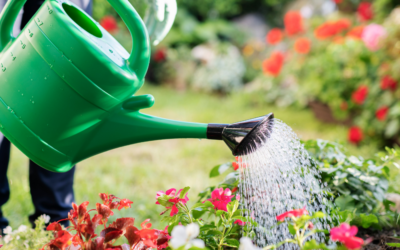If you just moved to a new property or want to enhance your yard, you may be interested in growing grass or starting a garden. Using fertiliser is the best way to achieve a healthy lawn and speed up growth.
Unfortunately, choosing between lawn starter fertiliser and the regular one can be daunting. If you pick the wrong type, it might affect ithe growth and establishment of your lawn.
Here, we provide the ultimate guide for differentiating these two options and identify the best ways to use them. We’ll also answer some fertiliser FAQs to help you learn more about these products.
What Is a Lawn Starter Fertiliser?
A lawn starter fertiliser contains nutrients that stimulates growth for new lawns. It can come in a liquid or granule form, depending on the brand you select. All lawn starter fertilisers contain phosphorus (P), nitrogen (N), and potassium (K).
Manufacturers often indicate the percentage of each component on the packaging using a fertiliser ratio, often referred to as a NPK ratio. The primary purpose of applying such products on your lawn is to provide new grass with the nutrients needed to grow faster and healthier.
What you need to know about Starter Fertilisers
Well first of all the term NPK “ratio” is misleading… It’s not a ratio at all. Yes that’s right it’s just something that’s been adopted to describe the figures you see for a fertiliser.
So when you see a NPK of 5:1:5, these are simply percentages of actual nutrient and are not a ratio. 5% Nitrogen, 1% Phosphorous and 5% Potassium.
Now that we’ve gotten that out of the way we can talk about real nutrient ratios and how they relate to plant growth. For normal maintenance growth, on lawns a maintenance fertiliser is commonly blended in a ratio, comparing everything to the main nutrient, nitrogen. So, as a general rule you will see plant nutrients like Potassium (K) applied at 50-80% of the nitrogen and Phosphorous (P) applied at 10% of Nitrogen.
Each nutrient has its role in the plant so when the plant is doing different processes then you need different nutrients. When a lawn is new it needs new roots and this 10% of phosphorous is no longer enough. It’s recommended to bring this up to approximately 50% of the nitrogen level to help these processes. This now creates a N:P ratio of 2:1, as seen in our LawnPlay Underlay product.
When to Use Starter Fertiliser on My Lawn?
When planting a new lawn it is always best to apply it to the soil before laying sod or seeding. This is important as the best starter fertilisers incorporate water crystals, these turn like jelly and you don’t want these on top of your lawn.
Whilst it may be tempting to speed up the growth, it’s always crucial to wait about 6–8 weeks before reapplying fertiliser. During the establishment process there is a lot of new growth and the plant is going through the transplant shock so it’s more susceptible to disease, over fertilising just increases the chances of this happening.
How to Use a Lawn Starter Fertiliser?
The first step to using lawn starter fertiliser is determining the correct amount. In most cases, this will differ depending on the nitrogen concentration in the product and yard size. If you aren’t sure about the right amount, check the packaging for instructions or consult an expert.
Once you identify the proper quantity, pour the fertiliser into a spreader and evenly apply it on the site. If you are fertilising before planting, make sure you work in the product at least 4–6 inches into the soil.
This precaution will prevent granules from blowing away.
What Is a Regular Fertiliser?
Maintenance fertiliser is often called a maintenance fertiliser, because it’s what you use for regular maintenance. Like a starter fertiliser it contains a combination of nitrogen, phosphorous and potassium. However, as discussed earlier it consists of a different ratio of these elements, one more suited to maintain normal growth habits.
When to Use Maintenance Fertiliser on My Lawn
The best time to use maintenance fertiliser is approximately 12 weeks after seeding. This is because, unlike starter fertilisers, maintenance ones don’t contain a high amount of phosphorus, which is essential for root growth in seedlings. Starting too early with a maintenance fertiliser could also result in burning of more susceptible new growth.
If you’re not starting a new lawn however then a regular fertiliser should be used 3 times a year. In Spring to break dormancy and wake up your lawn, in Summer to make sure nutrition is matching its growth and in Autumn to lengthen the growing period into winter and also to store nutrients to help with breaking spring dormancy.
In fact, the main difference between the best and the worst lawns in the street is usually just the type and frequency of fertiliser they used. So simply using LawnPlay All Rounder 3 times a year can have you turning your lawn game around.
How to Use a Regular Fertiliser?
Before applying regular fertiliser on your lawn, it’s vital to ensure the leaves of your lawn are dry. The fertiliser breaks down with water and we don’t want it breaking down in the morning dew where it could burn the leaf. Check the lawn is dry by rubbing your hand across it. .
Once dry, measure out the required amount for your lawn and start applying the fertiliser around the edges of your lawn. Starting with the edge will help you avoid missing any spots. You may then complete the process by filling in the middle part in a back and forth motion.
It’s advisable to reapply regular fertiliser on your lawn in Spring, Summer and Autumn . This way, you can ensure a steady flow of nutrients and keep your grass or plants healthy throughout the seasons.
Lawn Starter Fertiliser vs Regular Fertiliser: Which One Should You Use?
After learning about regular and starter lawn fertilisers, you may wonder about the best option for your property. In most cases, the ideal product will depend on whether you are planting new grass or nurturing existing one.
When planting new grass with either seed or sod, it’s best to use starter fertiliser. This one contains a perfect balance of nutrients for developing roots.
Some experts may advise using starter fertiliser on existing vegetation or alternating it with a regular one. This may happen if your soil contains a low amount of phosphorus. Still, it’s advisable to avoid this practice unless you take a soil test and get such advice from an expert.
Contact the Lawn Shed to Buy the Best Fertiliser
Applying lawn starter fertiliser to your yard will speed up grass and plant growth.At the Lawn Shed, we provide high-quality fertilisers with all nutrients needed to care for your lawn or garden.
Our products can help you deliver organic benefits to your soil and reduce adverse environmental effects by lowering water usage. Apart from providing fertilisers, we also offer professional lawn advice to ensure homeowners use products suitable for their soil. With our guidance, you can improve your lawn and garden maintenance experience. Contact us today to buy our products or consult an expert like our very own Lawn Genius.
Frequently Asked Questions
Getting answers to common questions about lawn starter fertiliser can help you determine the best practices and measures to observe during use. Continue reading for more information and guidance on using these products.
How Long Does It Take Fertiliser to Work?
After using lawn starter fertiliser, you need to wait for about a week to see notable results. Still, the amount of growth experienced will differ depending on whether you planted seeds or laid sod. Plus don’t forget, alot of the growth you want is under the soil.
Does Starter Fertiliser Need to be Watered In?
Most starter fertilisers don’t need watering during application. It’s best to wait for seed and turfing before application. It’s vital to ensure that the soil stays moist to promote seed germination and growth.
Can I Use a Starter Fertiliser All Year?
I’s best to replace it with a maintenance fertiliser once your lawn matures unless an expert suggests otherwise due to an imbalance of soil nutrition.
Can You Overapply Starter Fertiliser?
Like any other product, using too much lawn starter fertiliser isn’t suitable for your lawn. Always apply the recommended amount and wait for 12 weeks before reapplying.
Will Starter Fertiliser Harm Existing Grass?
Using lawn starter fertiliser on existing grass will not have significant effects. But it will lack vital nutrients, which will affect health. Not to mention the water crystals which will form jelly like on your lwns surface. The best practice is applying maintenance fertilisers on existing grass and the starter option only on areas with new sod or seedlings.




